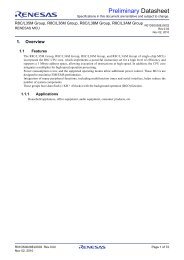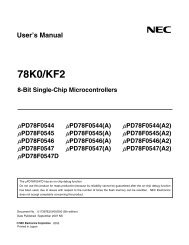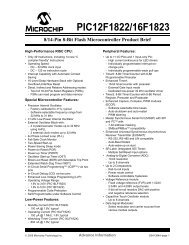xmega a3u - Elfa
xmega a3u - Elfa
xmega a3u - Elfa
You also want an ePaper? Increase the reach of your titles
YUMPU automatically turns print PDFs into web optimized ePapers that Google loves.
XMEGA A3U<br />
14. Interrupts and Programmable Multilevel Interrupt Controller<br />
14.1 Features<br />
• Short and predictable interrupt response time<br />
• Separate interrupt configuration and vector address for each interrupt<br />
• Programmable multilevel interrupt controller<br />
– Interrupt prioritizing according to level and vector address<br />
– Three selectable interrupt levels for all interrupts: low, medium and high<br />
– Selectable, round-robin priority scheme within low-level interrupts<br />
– Non-maskable interrupts for critical functions<br />
• Interrupt vectors optionally placed in the application section or the boot loader section<br />
14.2 Overview<br />
14.3 Interrupt vectors<br />
Table 14-1.<br />
Interrupts signal a change of state in peripherals, and this can be used to alter program execution.<br />
Peripherals can have one or more interrupts, and all are individually enabled and<br />
configured. When an interrupt is enabled and configured, it will generate an interrupt request<br />
when the interrupt condition is present. The programmable multilevel interrupt controller (PMIC)<br />
controls the handling and prioritizing of interrupt requests. When an interrupt request is acknowledged<br />
by the PMIC, the program counter is set to point to the interrupt vector, and the interrupt<br />
handler can be executed.<br />
All peripherals can select between three different priority levels for their interrupts: low, medium,<br />
and high. Interrupts are prioritized according to their level and their interrupt vector address.<br />
Medium-level interrupts will interrupt low-level interrupt handlers. High-level interrupts will interrupt<br />
both medium- and low-level interrupt handlers. Within each level, the interrupt priority is<br />
decided from the interrupt vector address, where the lowest interrupt vector address has the<br />
highest interrupt priority. Low-level interrupts have an optional round-robin scheduling scheme to<br />
ensure that all interrupts are serviced within a certain amount of time.<br />
Non-maskable interrupts (NMI) are also supported, and can be used for system critical<br />
functions.<br />
The interrupt vector is the sum of the peripheral’s base interrupt address and the offset address<br />
for specific interrupts in each peripheral. The base addresses for the Atmel AVR XMEGA A3U<br />
devices are shown in Table 14-1. Offset addresses for each interrupt available in the peripheral<br />
are described for each peripheral in the XMEGA AU manual. For peripherals or modules that<br />
have only one interrupt, the interrupt vector is shown in Table 14-1. The program address is the<br />
word address.<br />
Reset and interrupt vectors.<br />
Program address<br />
(base address) Source Interrupt description<br />
0x000<br />
RESET<br />
0x002 OSCF_INT_vect Crystal oscillator failure interrupt vector (NMI)<br />
0x004 PORTC_INT_base Port C interrupt base<br />
0x008 PORTR_INT_base Port R interrupt base<br />
0x00C DMA_INT_base DMA controller interrupt base<br />
8386B–AVR–12/11<br />
28

















